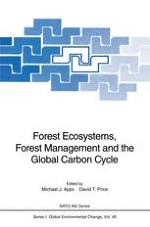1996 | OriginalPaper | Buchkapitel
Plantation forestry-its role as a carbon sink: conclusions from calculations based on New Zealand’s planted forest estate
verfasst von : J. Piers Maclaren
Erschienen in: Forest Ecosystems, Forest Management and the Global Carbon Cycle
Verlag: Springer Berlin Heidelberg
Enthalten in: Professional Book Archive
Aktivieren Sie unsere intelligente Suche, um passende Fachinhalte oder Patente zu finden.
Wählen Sie Textabschnitte aus um mit Künstlicher Intelligenz passenden Patente zu finden. powered by
Markieren Sie Textabschnitte, um KI-gestützt weitere passende Inhalte zu finden. powered by
It is common to encounter misunderstanding with regard to the role of forests as a means of mitigating the postulated enhanced greenhouse effect (Houghton et al. 1990, 1992). Some of the confusion appears to lie in loose terminology. In particular, the words carbon sink, and carbon reservoir need to be clearly distinguished (see Glossary). Only if a reservoir increases in capacity does it constitute a net sink, and then only for the period during which it is expanding in size. The word store, used as a noun, may be synonymous with reservoir, but as a verb it means to create a reservoir or to act as a sink; hence use of store should be avoided. Confusion also surrounds the word forest, which is frequently used synonymously with stand. Forestry terms used throughout this chapter will be as defined by the Society of American Foresters (1917) and by Ford-Robertson (1971); more important terms are italicized upon first use and definitions provided in the Glossary. Whereas a stand comprises trees of similar composition, age-structure and management regime, a forest is a larger unit that may consist of hundreds or thousands of stands. The dynamics of a forest are considerably more complex than those of a stand, as shall be explained later.
